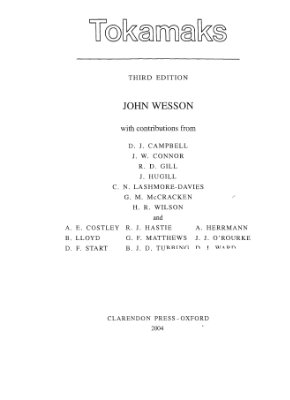THIRD EDITION. © CLARENDON PRESS-OXFORD, 2004.
When I worked on toroidal devices in the early days of fusion research the plasma temperatures achieved were around 10 eV and the confinement times were perhaps 100 microseconds. In the next thirty years there was steady progress and at the publication of the first edition of this book in 1987 the temperatures in large tokamaks were several keV and a confinement time of one second had been reached.
By then the tokamak had become the predominant device in the attempt to achieve a useful power source from thermonuclear fusion. The accompanying increase in research activity and general interest in tokamaks led to the need for an introductory account of the subject and it was the aim of the first edition to provide such an introduction.
In the subsequent decade up to publication of the second edition the subject was transformed again. There were now areas where the experimental behaviour could be understood in terms of accepted theory, which was encouraging. There had also been substantial research on large tokamaks leading to the long awaited achievement of significant amounts of fusion power. Inevitably this brought us face to face with the problems involved in designing and building a tokamak reactor. The aim of the second edition was to describe these advances, and it is perhaps a measure of the developments in the subject that the second edition was twice the size of the first. When the time came for a reprint the opportunity was taken of bringing the book up to date in this third edition. In the intervening period the emphasis has been on preparing the ground for an experimental reactor but there have also been significant advances in our understanding of the plasma behaviour, for example, the wider experience of inteal transport barriers, the appreciation of the role of tearing modes driven by neoclassical effects, and insights from turbulence simulations. /
Despite the increasing complexity of the subject it is hoped that the book will still prove useful to those entering the subject, to specialists within tokamak research who wish to acquire knowledge of other areas in the subject, and to those outside tokamak research who would like to lea something of the principal concepts, methods, and problems involved. A further aim is to provide a handbook of equations, formulas, and data which the research worker frequently needs.
I regard it as an honour to have worked with the distinguished physicists who are my co-authors. Their spirit of cooperation has made the endeavour a pleasure.
When I worked on toroidal devices in the early days of fusion research the plasma temperatures achieved were around 10 eV and the confinement times were perhaps 100 microseconds. In the next thirty years there was steady progress and at the publication of the first edition of this book in 1987 the temperatures in large tokamaks were several keV and a confinement time of one second had been reached.
By then the tokamak had become the predominant device in the attempt to achieve a useful power source from thermonuclear fusion. The accompanying increase in research activity and general interest in tokamaks led to the need for an introductory account of the subject and it was the aim of the first edition to provide such an introduction.
In the subsequent decade up to publication of the second edition the subject was transformed again. There were now areas where the experimental behaviour could be understood in terms of accepted theory, which was encouraging. There had also been substantial research on large tokamaks leading to the long awaited achievement of significant amounts of fusion power. Inevitably this brought us face to face with the problems involved in designing and building a tokamak reactor. The aim of the second edition was to describe these advances, and it is perhaps a measure of the developments in the subject that the second edition was twice the size of the first. When the time came for a reprint the opportunity was taken of bringing the book up to date in this third edition. In the intervening period the emphasis has been on preparing the ground for an experimental reactor but there have also been significant advances in our understanding of the plasma behaviour, for example, the wider experience of inteal transport barriers, the appreciation of the role of tearing modes driven by neoclassical effects, and insights from turbulence simulations. /
Despite the increasing complexity of the subject it is hoped that the book will still prove useful to those entering the subject, to specialists within tokamak research who wish to acquire knowledge of other areas in the subject, and to those outside tokamak research who would like to lea something of the principal concepts, methods, and problems involved. A further aim is to provide a handbook of equations, formulas, and data which the research worker frequently needs.
I regard it as an honour to have worked with the distinguished physicists who are my co-authors. Their spirit of cooperation has made the endeavour a pleasure.

